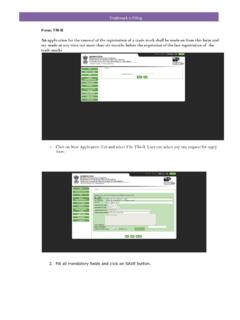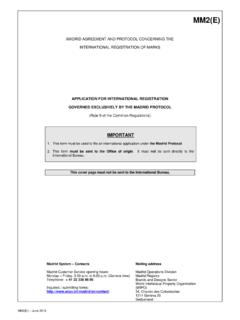Transcription of Form DM/1.inf (Hague System for the International ...
1 (E) February 2012 (E) madrid agreement AND PROTOCOL concerning THE International registration OF MARKS EXPLANATORY NOTES ON THE OFFICIAL APPLICATION form MM2 APPLICATION FOR International registration GOVERNED EXCLUSIVELY BY THE madrid PROTOCOL (Rule 9 of the Common Regulations) World Intellectual Property Organization 34, chemin des Colombettes, Box 18, 1211 Geneva 20, Switzerland Tel.: (41-22) 338 9111 Fax ( International Trademark Registry): (41-22) 740 1429 e-mail: Internet: (E) February 2012 EXPLANATORY NOTES FOR COMPLETION OF OFFICIAL International APPLICATION form MM2 1. This document aims to facilitate the completion of the official application form MM2 for the International registration of trademarks under the madrid System . The form must be completed legibly, and handwritten forms are not acceptable to the International Bureau of WIPO.
2 If an Office decides to produce its own self-generated version of the official form , such document must include the same content, format and numbering as the official form MM2. The final layout and spacing of self-generated forms may be modified to take account of the particular circumstances (for example, the inclusion, in sequential order, of the particulars of more than one single applicant). Language of the International Application 2. The International application may be in English, French or Spanish, according to what is prescribed by the Office of origin. That is, the Office of origin is entitled to restrict the choice of the applicant to just one language, or to two languages, or indeed, the Office may permit the applicant to choose between any of the three languages.
3 Thus, the applicant should ascertain from the Office of origin which language or languages must or may be utilized, in advance of the filing of the application through that Office. 3. If the requirements concerning language are not complied with, an International application will not be considered as such and will be returned to the sender. 4. The application form contains two boxes at the top of the first page. The box on the top left side may be used to indicate firstly, the number of additional continuation sheets (for example, if there is a long list of goods and services in item 10 of the form ), and secondly, to indicate the number of forms MM17 that may have been sent with the application form . (MM17 is the form that is used to file a claim of seniority in the event that the International application includes a designation of the European Union (see paragraph 104 below)).
4 APPLICATION form Item 1: Contracting Party whose Office is the Office of Origin 5. The Office of origin is the Office of the Contracting Party through which the applicant derives entitlement to file the International application. It is the Office in which the basic application will have been filed or the basic registration will have been recorded. 6. The name of the State whose Office is the Office of origin should be given in item 1 for example, China . If the Office of origin is the Office of the intergovernmental organization which is the European Union, then the indication European Union should be given. 7. If there is more than one applicant, the name of only one Contracting Party should be indicated as the Contracting Party whose Office is the Office of origin.
5 However, each applicant should be eligible or qualify, with respect to that Contracting Party, to file the International application through the Office in question (see paragraph 14 below). Item 2: The Applicant Name 8. Where the applicant is a natural person, the name to be indicated is the family (or principal) name and the given (or secondary) name(s) of the natural person as customarily used by that person and in the order in which they are customarily used. Where the applicant is a legal entity, its full official designation must be given. (E), page 2 (E) February 2012 9. Where the name of the applicant is in characters other than Latin characters, the name must be indicated as a transliteration into Latin characters, following the phonetics of the language of the International application.
6 Where the applicant is a legal entity, the transliteration may be replaced by a translation into the language of the International application. Address 10. The address of the applicant must be given in such a way as to satisfy the customary requirements for prompt postal delivery. Where no address of a representative is given in item 4, all communications will be sent to the address of the applicant given in item 2(b). 11. In addition, in item 2(d), telephone or facsimile numbers and an e-mail address may be given. The numbers or e-mail address given should be those of the person whom the International Bureau should contact when it needs to get in touch with the applicant. Address for Correspondence 12. Where the applicant requires that communications be sent to an address other than that indicated in item 2(b), an address for correspondence may, at the option of the applicant, be indicated in this space.
7 Otherwise, the field Address for correspondence should be left blank. An example of where it may be appropriate to indicate an address for correspondence may be the case where the International application is being filed by the in-house counsel of a company, and the company s address may differ from the address used by the in-house counsel. 13. NOTE: if it is intended to appoint a representative and thus to have all communications addressed to such representative, it is not correct to indicate the particulars of such representative in item 2(c) Address for correspondence . The appointment of a representative is achieved by completing item 4, which is discussed below. Several Applicants 14. Two or more applicants may jointly file a single International application, provided that the basic application or the basic registration is jointly owned by them.
8 Each of the applicants will be required to have entitlement to file (see Item 3: Entitlement to File ) with the Contracting Party whose Office is the Office of origin, which will be indicated in item 1 of the form . However, it is not necessary that the nature of the particular connection be the same for each applicant. Thus, Applicant 1 may be a national of the State which is the Contracting Party whose Office is to be the Office of origin, Applicant 2 may be domiciled in that State, and Applicant 3 may have a commercial establishment in that State. See also paragraph 7, above. 15. Where there is more than one applicant, the name and address of each applicant should be given, if necessary using a continuation sheet. 16. Where the International application is jointly filed by two or more applicants with different addresses, and neither the name and address of a representative nor an address for correspondence has been indicated, communications will be sent to the address of the applicant first named in the International application.
9 In the event that there are several applicants, it may therefore be useful to indicate a single address for correspondence in item 2(c). All correspondence will then be sent to that address. Preferred Language for Correspondence 17. The applicant may (by checking the appropriate box) indicate whether he wishes to receive communications from the International Bureau in English, in French or in Spanish, regardless of the language in which the International application was transmitted from the Office of origin to the International Bureau. On the other hand, if the applicant simply wishes to receive communications from the International Bureau in the language in which the International application was filed, it is not necessary to check any box. (E), page 3 (E) February 2012 18.
10 NOTE: this applies only to communications originating from the International Bureau; communications from Offices that are simply transmitted by the International Bureau, such as notifications of refusal, are sent in the language in which they are received from the Office in question. Other Indications 19. It is not compulsory to complete this part of the International application form . Nevertheless, the indications which are provided for in this part of the form are required by a number of Contracting Parties and if such indications are omitted, the applicant will be likely to meet with a provisional refusal from those Contracting Parties. It is therefore advised that applicants complete this part of the form . 20. Where the applicant is a natural person, he may indicate the State of which he is a national.







